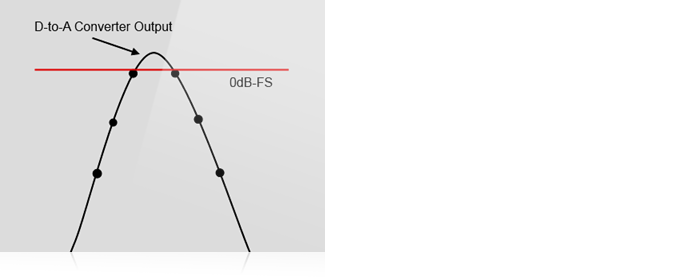Inter-Sample Peak Limiting
The Concrete Limiter employs an advanced, 16x Oversampled, 6th-order Windowed-Sinc, Interpolation mechanism that detects peaks in-between samples. The problem with sampling, in-general, is that even though individual samples may all fit under the 0dB-full-scale clipping level, the waveform can still clip in the analog domain.

The problem occurs when the DAC (digital-to-analog converter) output needs to reconstruct a smooth curve from a digitally sampled one (see graph). Many DACs are equipped to handle any analog overages, but some are not. Studio engineers often set the Output Ceiling level to -0.1dB, or similar, because of this frequent issue. A better solution is for the limiter to model (oversample) the DAC's output, and limit to the modeled, analog peak. The Concrete Limiter works this way.
Inter-sample Peak Limiting vs. True-Peak Limiting
True-peak Limiting is a form of Inter-sample Peak Limiting, and it simply means that method used to calculate the analog output is mathematically perfect. In theory, attaining perfection is impossible - because it requires a infinite amount of both look-ahead, and history, of the input signal. In practice, True Peak Limiters can earn their title with a few milliseconds (or more) of look-ahead. At that level of processing, the error becomes manageable, and falls below the threshold of hearing. True Peak Mastering Limiters are becoming commonplace, but with the true-peak accuracy, there also comes a heavier CPU-load, as well a higher plug-in latency associated with the extra look-ahead.
The ProChannel Concrete Limiter
It should be noted that the ProChannel Concrete Limiter is not considered to be a "True-peak Limiter". While it calculates inter-sample peaks and limits to them, its low-latency model may still allow analog- overages on very high-frequencies when they are driven hard (i.e. with low limiter threshold levels). The Concrete Limiter represents what we believe to be an excellent compromise between low-latency, low CPU-loading and output quality. With its smooth, frequency-dependent gain-reduction algorithm, it produces very transparent, level-limited output - with a minimum of audio artifacts.